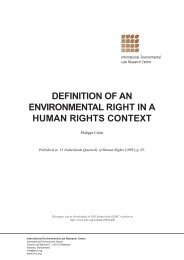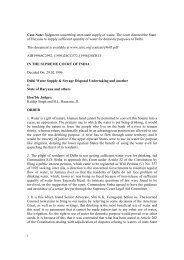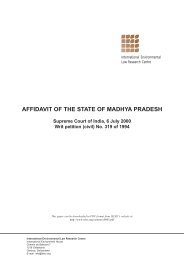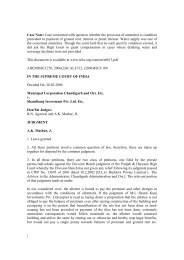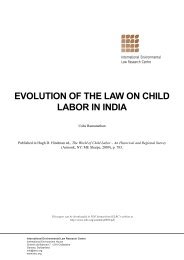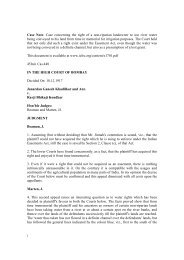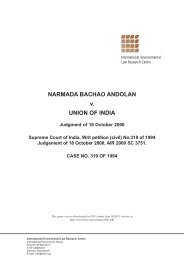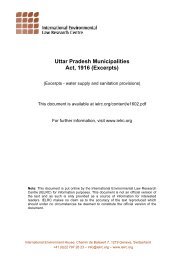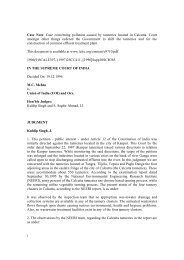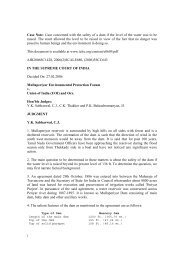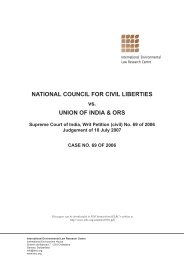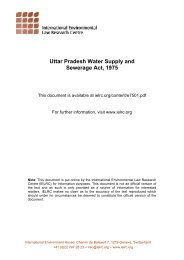IELRC.ORG - Raja Srinath Roy v. Dinnabandhu Sen
IELRC.ORG - Raja Srinath Roy v. Dinnabandhu Sen
IELRC.ORG - Raja Srinath Roy v. Dinnabandhu Sen
- No tags were found...
Create successful ePaper yourself
Turn your PDF publications into a flip-book with our unique Google optimized e-Paper software.
Case Note: Case concerning the fate of exclusive fishing rights granted by theGovernment in case of the changing of the course of a river. The Court held that as persettled law in Bengal the Government's grantee of a several fishery in a tidal andnavigable river can follow the shifting course of the river for the enjoyment of hisexclusive fishery so long as the waters form part of the river system within the upstreamand downstream limits of his grant. The Court held the existing English common law tobe inapplicable in this regard.This document is available at www.ielrc.org/content/e1401.pdf(1914)16BOMLR901IN THE HIGH COURT OF BOMBAYDecided On: 16.07.1914<strong>Raja</strong> <strong>Srinath</strong> <strong>Roy</strong>v.Dinabandhu <strong>Sen</strong>Hon'ble Judges:Moulton, Sumner, Parmoor, John Edge and Ameer Ali, JJ.JUDGMENTSumner, J.1. In this action the plaintiffs claimed, as proprietors of a several fishery in certain tidalnavigable waters in Eastern Bengal, a decree, for possession of an exclusive fishery in aportion of a river channel, of which the principal defendants own both the bed and thebanks. They succeeded before the Additional Subordinate Judge of Faridpur and Jailedon appeal to the High Court at Calcutta Hence this appeal to their Lordships' Board.2. There is a section of the river system of the Lower Ganges, between Dacca on the leftbank and Faridpur on the right, where the great stream divides and for many miles runs intwo channels roughly parallel with one another. The general course is to the south-east.The northern of the two channels is much the larger, but the southern, the smaller of thetwo, is itself wide. Both channels are tidal and navigable.3. The streams in the Gangetic delta are capricious and powerful. In the course of agesthe land itself has been deposited by the river, which always carries a prodigious quantityof mud in suspension. The river comes down in flood with resistless force, andthroughout its various branches is constantly eroding its banks and building them upagain. It crawls or races through a shifting network of streams. Sometimes its coursechanges by imperceptible degrees; sometimes a broad channel will shift, or a new oneopen in a single night. Slowly or fast it raises islands of a substantial height standing1
above high water level and many square miles in extent. Lands so thrown up are called"churs," and it is by chur-lands formed at some unknown though probably not remotedate that the northern and southern channels in question are at present divided.4. In the year-1897 a channel was broken through the defendants' chur-land in question.Though relatively small, even this stream was of considerable size; it is navigable forsmall craft, and is certainly within the ebb and flow of the tide. This new branch probablyfollowed a line of depressions already existing, one end of which was actually an armrunning up from the northern river.5. The plaintiffs claim the exclusive fishery in this new navigable channel as fallingwithin the up stream and downstream limits of their several fishery, and allege that thedefendants are trespassers when they fish in it. The defendants justify their claim to fishin a portion of this channel as part of the rights of owners of the subjacent soil and ofpersons claiming under them.6. That the plaintiffs are entitled to some fishery right in the river waters generally, notfar distant from the site-in question, never was much disputed, and was admitted by therespondents before their Lordships' Board, but they dispute its origin and its extent. Theysay that this branch is of origin so recent that no title by prescription or adversepossession arises as against themselves; that they are not affected by evidence ofprescription against third parties; that even a several fishery, duly created in the mainstream by the Government of India in right of the Crown, would not extend to this newbranch, still less would rights acquired in the main stream by prescription against otherriparian proprietors be exercisable in it; that the evidence neither establishes such boundsfor the alleged exclusive fishery upstream and down stream as would bring this branchbetween them, nor shows that in fact any julkar right was ever created by Government atall. In substance the Trial Judge found for an actual Government creation of the plaintiffs'right, as well as for the boundaries claimed by them. The High Court concluded againstthe plaintiffs on the question of the extent of their julkar rights without determining theirorigin.7. The evidence of the origin of the plaintiffs' rights is documentary, and does not dependon the credibility of witnesses. Chur Makundia is the name of the plaintiffs' pergunnah,They produced among many other documents (i) an Ekjai Hastbud in respect of it for theyear 1790, which showed that it then included a Mahal juikar; (ii) a hakikatchowhaddibandi of the lands and jamas of that pergunnah for the year 1795, whichshowed that the name of the julkar mahal was River Balabanta and Bil Baor withspecified boundaries, of which the Kole Churi of Alipur alone can'-now be traced byname, (iii) dowl kabuliyats of 1793 and 1799, specifying the amount of the dowl-jummaof the julkar, and (iv) an Issumnavisi Mouzahwari of 1821 mentioning the julkar in theRiver Balabanta as a mouza of pergunnah Chur Makundia. They <strong>Raja</strong> put in (v) arobokari of the Court of the Collector of Faridpur dated 11th January 1861, by which theGovernment recognized that this Julkar had been included as a mahal in the zamindaripergunnah Chur Makundia (formerly Touzi No. 110 in the Dacca Collectorate, and nowNo. 4,000 in that of Faridpur), since before the decennial settlement. It named the2
upstream and downstream limits, and stated that the Balabanta river, in which it wasenjoyed, was the same as that known in 1861 as the Padma, that is the larger and morenortherly of the two branches of the Ganges above described. The more southerly hasbeen known for some fifty years as the Bhubaneswar.8. Some evidence, not very distinct, was given at the trial apparently for the purpose ofshowing that no grant from the Government was any longer to be found among thepapers belonging to the plaintiffs' zamindari, but no point seems to have been made thenor since that the proper searches had not been made. Although, on the other hand, whenGovernment has created a separate estate of julkar at the period in question, it is usual tofind some entry of it in the decennial settlement papers, no evidence was forthcoming toshow that julkar grants made prior to the decennial settlement or that settlements withzamindars made at the time of it must necessarilly have taken the form of pottahs or someother muniments which should now be in the zamindar's possession, or be recorded in theGovernment archives still in existence. In practice such original grants are but rarelyforthcoming now, and resort must be had to secondary evidence of them, or to theinference of a legal origin to be drawn from long user (Garth C.J. in Hori Das Mal v.Mahomed Jaki (1885) I.L.R. Cal. 484. The Trial Judge was satisfied that the plaintiffshad proved a Government grant or settlement about the end of the eighteenth century. Hewas overruled by the High Court, not on the ground that no such grant was proved, butthat it was not shown to have been a grant of a several fishery of wide extent, The HighCourt thought that in reality it was only appurtenant to the plaintiffs' actual pergunnahand was limited by its riverine bounds.9. Their Lordships accept the rule laid down in the case of Hori Das Mal v. MahomedJaki (1885) I.L.R. 11 Cal. 434 (following the English rule in Fitzwalter's case 3 Kable242, that the evidence of a Government grant of an exclusive fishery in navigable watersought to be conclusive and clear, but they are of opinion that, in so far as such evidencecan now be expected to be forthcoming as to particular grants more than a century old,the evidence in the present case was sufficient to show that the competent authority theGovernment of India in right of the Crown-did actually grant to the plaintiffs'predecessors-in-title, or settle with them so as in effect to grant, a julkar right of severalfishery in certain of the waters of the portion of the Ganges system in question.10. The next point is one of metes and bounds. This depended partly on the above-nameddocuments, partly on the records of certain litigation with the neighbouring zamindars ofpergutr nah Bikrampur and persons holding under them in 1816 and 1843, put in as partof the history of the fishery and of the claims made to it, partly on the testimony of livingpatnidars, ijaradars, fishermen, and so on, and the local investigations of an ameendeputed by order of the Court. The ameen's reports and maps were accepted in bothCourts, and by both parties on the present appeal. The plaintiffs' case depended on fixingby means of the above materials, supplemented by a series of maps from 1760 onwards,four points roughly forming a parallelogram, within which their alleged julkar rights lay,the western or upstream boundary and the eastern or downstream boundary in each caseextending from points north of the northern or larger channel, the Padma, to points southof the southern or smaller channel, the Bhubaneshwar, and the locus hi quo of the dispute3
falling between them. The defendants contended, that in so far as any certain points wereproved at all, the materials relied upon only showed that the fishery did not extend intoany part of the Padma, but was limited by the right or southern bank of the main streamand thus excluded it. They pointed out that the Faridpur Collect orate was bounded by theright bank of the Padma, the whole breadth of the main stream being 111 the Collectorateof Dacca, and they argued that the robokari of 1861, which was the strength of theplaintiffs' case, proved at most a recognition of a fishery right, which stopped short ofthose waters in which it was now essential to the plaintiffs to make good their claim.11. A sufficient answer is made by the plaintiffs. They obtain early evidence of the actualposition of the points forming their boundaries north of the main stream fromproceedings in suits decided in their favour between themselves or their predecessors intitle and the owners of the Bikrampur zamindari, who claimed some julkar rights in themain Padma also, and Lord Sumner by means of such proceedings in 1797, 1816, and1843, by means of other similar proceedings in litigation with some of the presentdefendants in 1894, 1896, and 1897, and also by a long succession of ijara kabuliyats andpottahs, which they put in evidence, they prove de facto possession, as under their julkarrights, of the whole fishery in both streams between their upper and their lower limits. Itis an intricate task to trace the various spots mentioned from map to map, because of theperiodic diluviation of trees and houses, though these are the least transient of thelandmarks available. Matters are also complicated by variations in the names of therivers, Bhubaneshwar, Krishnapur, Narina, Padma, and Balabanta or Balbanta. Theresult, however, is sufficiently clear. Further, the decision recorded in the Robokari of1861 was appealed to the Commisssioner of the division at Dacca, who at that dateexercised appellate jurisdiction in such matters over the CoUectorate of Faridpur, and haaffirmed the decision below. As this decision proceeded on the footing that the julkarclaimed extended over the waters of the Padma, and was a valid julkar included in thepermanent settlement, it may reasonably be inferred that the Commissioner of Dacca tooknote that the parties entitled to the julkar, claimed rights within his collectorate, andfinding nothing in the Dacca records to the contrary, affirmed the decision below forDacca as well as for Faridpur.12. The Trial Judge, following a long and considerable body of decisions in Bengal, heldthat, if the plaintiffs' rights in this stream or streams out of which the new branch openedwere once established, they would extend to the waters of the new branch as soon as itwas formed, a principle which is conveniently called "the right to follow the river." Itdoes not appear that this current of authority was challenged or doubted either before theTrial Judge or the High Court; certainly its authority was binding upon both. Thedefendants' case simply was that in fact neither the plaintiffs nor their predecessors intitle could be shown ever to have enjoyed or to have been entitled to any julkar rightexcept that lying within the boundaries of their zainindari and appertaining thereto. TheHigh Court appears to have arrived at a conclusion in favour of the defendants' argumentmainly in consequence of the view taken of the true meaning of the judgment of 1816,and of the significance of the Thakbast map of 1862, and a marginal note upon it. It is notnecessary to examine the language of the judgment of 1816 in detail, but their Lordshipsare unable to hold that it excluded the main or northern stream from the plaintiffs' fishery,4
either expressly or by implication. The language is obscure, but, as their Lordships readit, the plaintiffs' construction of it was right. The Thak map was pressed beyond itslegitimate effect. It was concerned only with that portion of the fishery which fell withinpergunnah Bikrampur and was inconclusive.13. The question of the effect of deltaic changes in a river's course upon the exclusiveright of fishing in it appears in the Indian decisions as long ago as the beginning of thelast century. It was laid down in 1807 that if a river changes its bed the owner of julkarrights in the old channel continues to enjoy them in the new one : Ishurchund Rai v.Ramchund Mokhurja (1807) 15 D.A. Rep. 221. 1 mor. Dig. 561. The converse caseoccurred in the following year. A landowner sued the owner of julkar rights in a tidalriver for taking possession of a jheel formed on his land by the overflow of the river. Thechannel of the river had not altered, the jheel formed no part of it, and was onlyconnected with it at the river's highest stage. Accordingly, it was held that the owner ofthe fishery, having no right over the plaintiffs' land, had no right to the fishery in watersthus formed upon his lands (Gopeenath Ray v. Ramohunder Turklunhar (1808) 1 Mac.Sel. Rep. 228; 2 Sevesrt. 467 note). This assumed some right of following the river andplaced a particular limit upon it. It will be observed so far that whatever may have beenthe basis for the right of julkar in the river, the right of fishing in the jheels was treated asbelonging to the owner of the subjacent soil, a right which was shortly after, in 1813, heldto be severable from the ownership of the soil, so that the bare grant by the landowner ofthe right of fishing in the heel did not in itself convey any property in the soil (ukheeDasee v. Khatima Beebee (1813) 2 S.D.A. Rep. 51. Why the owner of julkar right in theriver has or may have an enjoyment of that right co-extensive with the waters of the riverwhich permanently form part of it, though they have changed their course, is not stated.Not improbably it rested on local custom, for the Bengal Alluvion and DiluvionRegulation (No. XI. of 1825) Lord Sumner is careful on a cognate matter to keep localcustom alive. At any rate the principle was well established as early as 1808 that a rightof fishery follows the river whatever course it may take, for the ground on which inGopeenath's case the High Court allowed the appeal from the Court below, which hadacted on this principle, is simply that in point of fact the jheel in question, though formedby the river's overflow, was no longer so connected with it as to form part of the river.This was long considered to have been the effect of these decisions. Mr. Sevester's noteupon them in Vol. 2, p. 467, of his Reports is, " the general right of fishery in a river(when not otherwise defined) is restricted to the channel of the river, and waterconsidered to form part of it; not extending to adjacent lakes or other pieces of wateroccasionally supplied by overflowings of the river, but not actually connected with thechannel of it. " The rule was so applied in 1856 (Nubki-shen <strong>Roy</strong> v. Uchchootanund(1856) 2 Sevestre 465 nots, and in 1863 in Ramanath Thakoor v. EshanchunderBonnerjee (1863) 2 Severstre 463. In the former it was held that the right of julkar in theriver was confined to the river and streams flowing into or from it, exclusive of jheels notconnected with the channel but extending to watercourses which though not immediatelywithin the great channel of the river adjoin or flow into it or are supplied therefrom; "their right consists of the flowing stream and the adjuncts flowing from or into it. " In thelatter the limitation of the river's adjuncts flowing from or into it was held not to extendto adjacent sheets of water with which the river communicates only when in flood. " We5
think, " says the Court, " the grant of julkar must be construed as prima facie confined tothe rivers and sheets of water communicating therewith to which the plaintiff might getaccess without trespassing on the land." It is true that these two decisions do notspecifically deal with the case of the changed channel of a deltaic stream, but they doclearly lay down rules for defining -the-area of the waters in which the julkar right is tobe enjoyed, which carry it beyond the limits of actual navigability though confining it towaters which are adjuncts of the navigable stream. They make the <strong>Raja</strong> right depend onthe identity of the river in which it is enjoyed and do not confine it to such waters of thatriver as are superimposed on the very land once owned by the grantor of the right. Thecurrent of decision was not unruffled by doubts. The Court Lord Sumner observes in1859 in Gureeb Hossein Chodhree v. G. Lamb (1859) 20 S.D.A. Rep. 1357-1361, " thepart of the country through which the Megna flows is intersected with innumerablecreeks into which the tide from the main river flows. The right of fishing in these tidalcreeks" belongs of right to the owner of the property into which they flow,' but this caseis explained by the fact that the part of the river in question was almost if not quite anarm o the sea. An opinion was indicated in 1864, though not absolutely necessary to thedecision, in Moharanee Sibessury Dabee v. Lukhy Dabee (1864) 1 W.R. 88 that theextension of rights of fishery, in consequence of an expansion of the river in which theywere enjoyed, ought-to depend, as questions of alluvion would, upon the rapidity of theexpansion. If sudden, it would work no change in the ownership of the submerged soil,and so cause no extension of the julkar right; it would do both if it took place by gradualand imperceptible advances. The Court here-inclined to connect the right of fishingindissolubly with the right to the soil subjacent to the waters in which the fishery rightwas enjoyed. In 1866 came two somewhat contradictory decisions. The Court in NobinChunder <strong>Roy</strong> Chowdry v. Radha Pearee Debia (1866) 6 W.R. 17 scouted as"preposterous " a claim to follow the diverted waters in which the plaintiff had- thefishery, but this was without discussion of the authorities, and the claim was alleged notagainst the owner of the soil over which the diverted waters flowed but against the ownerof the fishery in the waters of another river into which the plaintiff's river had burst anddischarged itself. In the second case, Gobind Chunder Shaha v. Khaja Abdool Ounnie(1866) 6 W.R. 41 the plaintiff and defendant, joint owners of land of a fishery, had madea partition of the land but not of the fishery, and the plaintiff sought to oust the defendantfrom fishing over the land, which now belonged exclusively to him but had beenoverflowed by a change in the course of the waters. Sir Barnes Peacock in dismissing thesuit observes : "Still, the fishery existed in that part of the river out of which the fish wastaken, although by a change in the course of the river it ran over that portion of the landwhich was allotted to the plaintiff under the butwara partition. " Again, in Krhhnendto<strong>Roy</strong> Chowdhry v. Maharanee, Surno Moyee, (1873) 21 W.R. 27 the Court somewhatreluctantly followed the rule, which it deemed to be settled, that the owner of the fisherywhere the river's channel has changed has "a right to follow the current, " that he " maynot only follow the river to any channel which it may from time to time cut for itself, butmay continue to enjoy, together with the open channel, and closing or closed channelsabandoned by the river...right up to the time when the channel became finally closed atboth ends." Upon the facts of that case it is the latter part of this proposition that isdirectly involved in the decision. The whole question was learnedly reviewed by Mr. LaiMohun Doss in 1891 in his Tagore Lectures on the Law of Riparian Rights, who (pages6
372, et seq.) while admitting a settled current of authority in India to the contrary, urgesthe very arguments and conclusions of the now respondents and relies on the sameauthorities. Nevertheless, after this discussion had brought the question again before theCourts and the profession, the High Court in a critical decision affirmed the long standingrule. This was in 1890 in the case of Tarini Churn Sinha v. Watson & Co. (1890) I.L.R.17 Cal. 963. The questions were directly raised: " Whether a right of julkar in a publicnavigable river can exist apart from the right to the bed of the river, or must it necessarilyfollow that right” " Do the defendants lose their vested right by a change in the river'scourse, though the river still is navigable and subject to public right?" This case raised thevery question which has been in debate before their Lordships, for the change in theriver's course was a sudden one taking place in the course of a single year and riot byimperceptible or slow encroachment. The answer given by the Court was in favour of theowner of the right of fishing in the river. It purported to follow a converse decision inJames Gray v. Anund Mohun Moiter (1866) 6 W.R. 108 and decided that "so long as theriver retains its navigable character it is subject to the rights of the public, and the fisheryremains in the person who was grantee from the Government." In Gray's case a change ofchannel had left an old bed either dry or containing only pools disconnected <strong>Raja</strong> with theriver, and it was held that what the river had abandoned, albeit part dry land and partjheels, became private property. Thenceforth it belonged to the riparian owners whocould claim settlement of it from Government, and the reason given is that " the right ofthe defendant” (the owner of the fishery), "being granted out of and part of theGovernment's right to the river, no longer exists when the Government's right is itselfgone. " Thus it will be observed that in Tarini's case the Court conceived itself to bereducing the subject to symmetry by deciding that while on the one hand the owner of thefishery rights in the river lost them where there was permanent recession of the river, heincreased them where there was permanent advance of the river. In the latter case theCourt disregarded the conception of Government right to the river as being an incident ofGovernment right to the subjacent soil, and treated the Government right and the right ofits grantee in respect of the fishery as subsisting in the river wherever that river mightflow, and not as subsisting in flowing water only where and so long as it flowed over soilvested in the Government. This view has since been treated as established-. That thejulkar right in the river extends over a piece or water formed originally by the river, butso far diled up as to be disconnected from it, except in the rains, during and just afterfloods, was decided in 1905 in Jogendra Narayan <strong>Roy</strong> v. Crawford (1905) I.L.R. 32 Cal.1141. The ground of the decision is that such water is still part of the river system, andwhen that is so in fact the right of fishing persists in respect of it. This is the case ofretrocession. So too in the case of Bhaba Prasad v. Jagadindra Nath Rai (1905) I.L.R. 33Cal. 15, 18 in the same year the principle is thus expressed: " the julkar rights weresettled with the plaintiffs' predecessor many years ago. The plaintiffs by virtue of thesettlement conferred upon them are entitled to exercise the right of fishery in the saidriver wherever it flows within the limits prescribed in the settlement itself. " Both thesecases purport to follow Tarini's case, which was a case of an advance of the river into anewly formed channel, and the rest of a long line of settled authorities. It must now betaken as decided in Bengal that the Government's grantee can follow the shifting river forthe enjoyment of his exclusive fishery so long as the waters form part of the river systemwithin the upstream and downstream limits of his grant, whether the Government owns7
the soil subjacent to such waters as being the long-established bed, or whether the soil isstill in a riparian proprietor as being the site of the river's recent encroachment.14. Their Lordships were strongly and ably pressed to disregard, or at least to qualify,these decisions. The points made were (a) that in principle the right to grant a severalfishery in tidal navigable waters is so essentially connected with the right to the soil andthe bed of the channel, that no fishery right can exist where the grantor of the severalfishery never has owned the subjacent soil; (b) that in any case the acquisition of freshwaters can go no further and can proceed no otherwise than the acquisition of fresh soilby alluvion, and therefore that an expansion of waters within which julkar right exists canonly carry with it an extension of the julkar right if it has taken place by imperceptibleencroachments upon the land, and not by sudden irruption j and (c) that it would begrossly unjust to hold that the natural misfortune which swamps a landowner's soil by ariver's encroachment should be accompanied by a legal ouster from such enjoyment asthe natural disaster has left him. In extension of the last point it was argued that thedisputed site in fact covered the sites of former enclosed jheels which belonged to andhad been enjoyed by the defendants, and that no trespass could be committed as againstthe plaintiffs in any view by fishing where the defendants had formerly been accustomedand entitled to fish in waters overlying their own land. This question of fact, which seemsnot to have been passed upon by the Courts below, was not sufficiently made out, buteven if it were, it appears to be covered by the general argument.15. For these contentions reliance was placed on the Mayor, &c. of Carlisle v. Graham(1869) L.R. 4 Exch. 361-368 where Kelly, C.B., says : " We are called upon to decide thequestion which now arises for the first time,-Is the several fishery of a subject in a tidalriver, the waters of which permanently recede from a portion of its course and (low intoand through another course, where the soil and the land on both sides of the new channelthus formed belong to another subject transferred from the old to the new channel, and soa several fishery created in and through out such new channel, or in some, and if in any,in what part of it?.... In the case of Murphy v. Ryan (1868) 2 C.L. 143,149. O'Hagan, J.,in delivering the judgment of the Court, says, ' But whilst the right of fishing in freshwater rivers in which the soil belongs to the riparian owners is thus exclusive, the right offishing in the sea, its arms and estuaries, and in its tidal waters, wherever it ebbs andflows, is held by the common law to publici juris and so to belong to all the subjects ofthe Crown, the soil of the sea, and its arms and estuaries and tidal waters being vested inthe Sovereign as a trustee for the public. The exclusive right of fishing in the one case,and the public right of fishing in the other, depend upon the existence of a proprietorshipin the soil of the private river by the private owner, and by the Sovereign in a public riverrespectively.' And this is the true principle of the law touching a several fishery in a tidalriver. If, therefore, the right of the Crown to grant a several fishery in a tidal river to asubject is derived from the ownership of the soil, which is in the Crown by the commonlaw, a several fishery cannot be acquired even in a tidal river if the soil belong not to theCrown but to a subject. And all the authorities, ancient and modern, are uniform to theeffect that if, by the irruption of the waters of a tidal river, a new channel is formed in theland of a subject, although the rights of the Crown and of the public may come intoexistence and be exercised in what has thus becomes a portion of a tidal river or of an8
arm of the sea, the right to-the soil remains in the owner, so that if at any time thereafterthe waters shall recede and the river again change its course, leaving the new channel dry,the soil becomes again the exclusive property of the owner, free from all rightswhatsoever in the Crown or in the public.16. With this case has to be considered also Foster v. Wright (1873) 148. There theproprietor of a right of fishing in the Lune, at that part neither tidal nor navigable, washeld entitled to "follow his river "when the river had so far shifted its course as to flowover another's land, and the person, to whom the land which came to form its new bedhad previously belonged, was held to be a trespasser when he fished in its new channel.The change of bed had been gradual, perceptible and measurable over considerableperiods of time, <strong>Raja</strong> but from week to week imperceptible. It was held that theimperceptible changes had had the effect of producing an accretion to the land of theowner of the fishery, and that “the river has never lost its identity, nor its bed its legalowner," (page 446); " he has day by day and week by week become the owner of thatwhich has gradually and imperceptibly become its present bed, and the title so graduallyand imperceptibly acquired cannot be defeated by proof that a portion of the bed nowcapable of identification was formerly land belonging to the defendant or hispredecessors-in-title." The Mayor & c. of Carlisle v. Graham (1869) L.R. 4 Exch. 361,367-368 was distinguished on the ground that in that case the river bed was a new bed notformed by the gradual shifting of the old one but totally new, the old bed remainingrecognisable in its old site but deserted. The Eden became a river with two beds the Lunewas at all times a river with only one though an ambulatory one. As counsel in Foster v.Wright (1878) 4 C.P.D. 438 boldly argued for the right to " follow the river " in its Indiansense saying (page 440), " even a sudden and violent change in its course would not havetaken away " the plaintiff's right, and as the adoption of that a fortiori view would havemade all consideration of gradual accretion immaterial, the decision must be regarded asone which negatives the contention of the respondents in the present case. As with theriver Luna so the part of the river Eden which was in question in the Mayor &c. ofCarlisle v. Graham (1869) L.R. 4 Exch. 361, 367-368 is one which does not appear to besubject to frequent change. How the law might be if conditions similar to those of Bengalcould occur in England is another matter. The above cases would 'have been moredirectly in point had the river in question been one which often and swiftly changes itscourse, as for instance the tidal Severn, of which Hale writes (Hargrave's Law Tracts, p.16), " that river, which is a wild unruly river, and many times shifts its channel,especially in that flat between Shinberge and Aure, is the common boundary between the"manors of either side, viz., the filum aquae or middle of the stream, and this is thecustom of the manors contiguous to that river from Gloucester down to Aure." There is inthis part of the Severn an ancient several fishery, enjoyed by the Lords of Berkeley undercharters of Henry I., Richard I., and John, which must be much more analogous to thejulkar in the present case than cases in the rivers Eden or Lune. A somewhat similarinstance in Scotland is mentioned by Siunath Lord Abinger in In re Hull and SelbyRailway (1839) 5 M & W 327 but the question of the right to follow the river does notappear to have arisen for decision in these cases.9
17. It was admitted that the common law of England as such does not apply in themofussil of Bengal, but the argument was that principles established under and forEnglish conditions afford a sound guide to the rules which should be enforced in India.Their Lordships have given these arguments careful consideration, though they would inany case be slow to disturb decisions by which rules have been established for Bengalgoverning extensive and important rights such as rights of julkar, and unless they couldbe shown to be manifestly unjust or flagrantly inexpedient, their Lordships would notsupersede them. The Indian Courts have in many respects followed the English law ofwaters. Sometimes their rules are the same; sometimes only similar. Julkar may exist notonly as a right attaching to riparian ownership but also " as an incorporeal hereditament, aright to be exercised in the tenement of another " (Forbes v. Meer Mahomed Hossein(1873) 12 Ben. L.R. 210, 216, as a profit a prendre in alieno solo (Lukhee Dassee v.Khatima Beebee (1813) 2 S.A.D. Rep. 51. In navigable waters such rights are granted bythe Government of India, or, what is equivalent to a grant, settled with the grantee underthe Revenue Settlement by the Government, and are thus derived from the Crown :Prosunno Coomar Sircar v. Ram Coomar Parooey (1878) I.L.R. 4 Cal. 53. The freeholdof the bed of navigable waters was deemed to be in the East India Company asrepresenting the Crown and now is vested in the Government of India in right of theCrown (Doe. dem. Seebkristo v. The East India Company (1856) 6 Moo. I.A. 267; 10Moo P.C.C. 140. Nogender Chunder Ghose v. Mahomed Esof (1872) 10 Ben. L.R. 406;18 W.R. 113. Where the bed thus forms part of the public domain the public at large isprima facie entitled to fish. Thus the English analogy has been closely followed. Again,the sudden invasion of a private owner's land by the waters of a navigable river does notdivest the property in the soil. If the change in the course of the navigable river results inthe water in the new course being in fact navigable (that is, capable of being traversed bya boat at all seasons, Chunder Jaleah v. Ram Churn Mookerjee (1871) 15 W.R. 212;Mohinee Mohun Doss v. Khajah Assanoollah (1872) 17 W.R. 73 the flooded landownermust submit to have his land traversed by the vessels of the public in the course ofnavigation and cannot in right of his ownership erect works on his flooded soil to theobstruction of the navigation. None the less he remains the owner, and should the waterspermanently retire his full rights as owner revive unless lapse of time or circumstances,or both suffice to prove an abandonment of his rights of ownership for his part.18. Still, there is one step which the Indian law has never taken, far as it has gone in theadoption of English rule, Often as the opportunity for so doing has arisen, it has neverbeen held that the capacity of the Government of India to grant to or settle with a privateowner the exclusive right of fishing in tidal navigable waters is so indissolubly bound upwith its ownership of the soil subjacent to those waters that, no matter how those watersmay subsequently change their court while still remaining part of the same river systemwithin the up-stream and down-stream limits of the grant The enjoyment of the right sogranted cannot extend beyond the limits of the Government's ownership of the soil lyingperpendicularly underneath them, as it may vest from time to time. It is one thing topresume the soil of the bed of a tidal navigable river to be vested in the Crown and tohold that the Government of India in right of the Crown can grant the fishery in thesuperincumbent waters in severally, and quite another to hold that the several fisherywhen once thus created is for eve enjoyable only in waters that continue to flow Precisely10
over ground which was in the Crown at the date of the grant. "Whether the actualproprietary right in the soil of British India," says Garth, C.J., in the case of Han Das Maialready cited, "is vested in the Crown or not (a point upon which there seems somediversity of opinion) I take it to be clear that the Crown has the power of makingsettlements and grants for the purposes of revenue of all unsettled and unappropriatedlands, and I can see no good reason why they should not have the same power of makingsettlements of julkar rights and of lands covered by water as of land not covered bywater. In either case the settlement is made for the purpose of revenue and for the benefitof the public." Again, the rights of the Crown are thus stated in The Collector of Maldahv. Syud Sudurooddeen (1964) 1 W.R. 116 :- "The claim to resume lands is one based onthe right of the Government to a portion of the produce of every beegah of the soil asrevenue, whereas the claim to possession of the julkars of rivers not forming portions ofsettled estates is founded upon a supposed right in Government as trustee of thewaterways of the country, to possess and to assign the exclusive possession of them toany individual it chooses on the payment of revenue for them in the shape of a fisheryrent. " (Hurreehur Mookerjea v. Chundeechurn Dutt (1888) 17 S.D.A. Rep. 641;Collector of Rungpore v. Ramjadub Sein (1863) 2 Sevester 373; see, too, Radha MohunMundul v. Neel Madhub Mundul (1975) 24 W.R. 200 and Satcowri Ghosh Mondal v.Secretary of State for India (1894) I.L.R. 22 Cal. 252, where the cases are collected anddiscussed.)19. In truth the rule which in the United Kingdom thus connects the subject's right to anexclusive fishery in tidal navigable waters with the limits of the Crown's ownership of thesubjacent soil is itself the result of conditions partly historical and partly geographicalwhich have no counterpart in Lower Bengal. In Bracton's time this rule would seem tohave been unknown; at any rate he ignores it, and treats the right of fishing in rivers, asdid the Roman law, as a right publici juris. Whether in his time this was at common laworthodox or heterodox, or whether he supplemented the defects of our insular system by areversion to that of Rome, need not now be considered. What is clear is that during themany years between his time and Hale's the generality of the right of river fishing, if itever had been the doctrine of the common law, was such no longer. According to Hale(De Jure Maris, page I, chap. IV; Hargrave's Law Tracts, page II), "The right of fishing inthis sea and the creeks and arms thereof is originally lodged in the Crown, as the right ofdepasturing is originally lodged in the owner of the waft whereof he is lord, or as theright of fishing belongs to him that is the owner of a private or inland river.... The King isthe owner of this great waft, and as a consequent of his propriety hath the primary right offishing in the sea and the creeks and arms thereof." Be it observed that this doctrine maybe called essentially insular, and that the proofs of it which Hale adduces are purelyEnglish, namely, Close Rolls, Parliament Rolls, and Rolls of the King's Bench mainly inPlantagenet times, and that he places on Bracton's Roman doctrine an interpretation,confining it to rivers which are arms of the sea, which is itself a dissent from thatdoctrine. The question how far a rule established in this country can be usefully appliedin another, whose circumstances, historical, geographical, and social, are widelydifferent, is well illustrated by the case of navigability as understood in the law of thedifferent States of the United States of America. Navigability affects both rights in thewaters of a river, whether of passing or repassing or of fishing and the rights of riparian11
owners, whether as entitled to make structures on their soil which affect the river's flow,or as suffering in respect of their soil quasi- servitudes of towing, anchoring, or landing infavour of the common people. The Courts of the different States, minded alike to followthe common law Where they could, found themselves in the latter part of the eighteenthand the early part of the nineteenth centuries constrained by physical and geographicalconditions to treat it differently. In Massachusetts, Connecticut, New Hampshire, andVermont, where the rivers approximated in size and type to the rivers of this country, theEnglish common law rule was followed, that tidality decided the point at which theownership of the bed and the right to fish should be public on the one side and private onthe other. Other States, though possibly for other reasons since they possessed rivers verydifferent in character from those of England, namely, Virginia, Ohio, Illinois, and Indianafollowed the same rule. But in Pennsylvania, North Carolina, Iowa, Missouri, Tennessee,and Alabama, this rule was disregarded, and the test adopted was that of navigability infact, the Courts thus approximating to the practice of Western Europe (see Kent'sCommentaries, iii, 525). The reasoning has been put pointedly in Pennsylvania. ChiefJustice Tilghman says in 1810, in Carson v. Blazer (1810) 2 Binney 477: "The commonlaw principle concerning rivers" (viz., that rivers, where the tide does not ebb and flow,belong to the owners of adjoining lands on either side), " even if extended to America,would not apply to such a river as the Susquehanna, which is a mile wide and runsseveral hundred miles through a rich country, and which is navigable and is actuallynavigated by large boats. If such a river had existed in England no such law would everhave been applied to it." (See too, Shrunk v. Schuylkill Navigation Co. 1 Watt &Sergeant 857. R 116). Thirty years later in Zimmerman v. Union Canal Co. (1826) 14Sergeant & Rewle 78 President Porter observes : " The rules of the common law ofEngland in regard to the rivers and the rights of riparian owners do not extend to thiscommon wealth, for the plain reason that rules applicable to such streams as they have inEngland above the flow of the tide scarcely one of which approximate to the size of theSwatara, would be inapplicable to such streams as the Susquehanna, the Allegheny, theMonongahela," and sundry other " rivers of Damascus." A similar deviation, equallygrounded in good sense, from the strict pattern of the English law of waters lies at thebottom of the current of Indian cases previously referred to, and forms its justification.20. In proposing to apply the juristic rules of a distant time or country to the conditions ofa particular place at the present day, regard must be had to the physical, social, andhistorical conditions to which that rule is to be adapted. In England the rights of theCrown and other rights derived from them have long been established by authority, eventhough their historical origin is imperfectly known or conjectural. The result may be thatthe law is quite certain and yet is based on considerations of history and precedent whichare quite the reverse. In Bengal a special history, and a special theory of rights, tenuresand obligations condition the rules applicable to such an incorporeal hereditament as thatnow in question In England we go back before Magna Charta for the commencement ofseveral fisheries in tidal navigable waters, and know little of their actual origin. In Bengalit is sufficient to say that at the time of the decennial or the permanent settlement or since,such rights, though possibly descending from remote antiquity, were settled with theGovernment of India, whose special position, originating on 12th August 1765, when theEast India Company became receiver-general in perpetuity Of the revenues of Bengal,12
Orissa, and Behar, is historically well known. English tenures and Bengal zemindarirights, unduly assimilated at one time, have never fully corresponded to one another.Above all the difference, indeed the contrast, of physical conditions is capital. In Englandthe bed of a stream <strong>Raja</strong> is for the most part unchanging during generations, and alters, ifit alters at till, gradually and by slow processes. In the deltaic area of Lower Bengalchange is almost normal in the systems, and changes occur rarely by slow degrees, andlord Sum often with an almost cataclysmal suddenness. If English cases were applied toBengal, so that the area of enjoyment of a several fishery in tidal navigable waters shouldbe limited to the area within which the Crown, the assumed grantor of the fishery, hadowned the subjacent soil at the time of its grant, who could say from time to time whatthe bounds of that enjoyment are, and where the ownership of the soil is to be delimited ?The course of the waters has been in flux for ages : at what date is this ownership to betaken ? As Lord Abinger says of the rule of gradual accretion of soil in In re Hull andSelby Railway (1839) 5 M. & W. 327 the theoretic basis of which has been variouslystated from the time of Blackstone to the present day (see the different theories collectedby Farwell, L.J., in Mercer v. Denne (1905) 2 Ch. 538, 558. "The principle is founded onthe necessity which exists for some such rule of law for the permanent protection andadjustment of property." Take which date you will, the ever-shifting river does not runnow where it ran then, and if the ownership of the soil remains as it was, it is sheerguesswork to say in which part of the present waters the grantee of julkar rights shallenjoy his several fishery under his grantor's title, and in which parts he must abstain,since the waters flow over the soil of private owners? Any given section of the riversystem is in all probability a shifting and irregular patch-work of water flowing over soilwhich belonged to the Sovereign at the selected date and of water flowing over soil thenbelonging to other owners and since encroached upon, with the back ground of aprobability that before the date in question, and yet within historic times, no water mayhave run there at all. By what analogy can rules applicable to the Eden and the Lune beprofitably applied to such physical conditions 121. It was urged that the established rule with regard to alluvion should be applied torights of julkar; that since the right to accretions and the liability to derelictions of soilattached only to gradual accretions or to erosions taking place by imperceptible degrees,so too the right of the owner of the fishery to "follow the river" ought to be limited tocases where the river's encroachments were gradual, and ought not to be extended to anirruption as sudden, and accomplished as rapidly as was the formation of the channel inquestion in the defendants lands. It is to be observed that here too Indian law, doubtlessguided by local physical conditions, has adopted a rule varying somewhat from the ruleestablished in this country. Where under English conditions the rule applies to "imperceptible" alterations, Regulation XI of 1825, Articles 1 and 4, speak of "gradualaccession." The analogy of the English rule can hardly be prayed in aid when Indianlegislation has thus an established and different rule on the same subject. Further, as theIndian rule is established now beyond question, it may perhaps be said without offence ofthe Indian as of the English rule, that it represents rather a compromise of conveniencethan an ideal of justice, for that which is a man's own does not become another's anymore agreeably to ideal justice by being filched from him gradually instead of beingswallowed whole. In any case the analogy is not in pari materia. Property in the soil is13
one thing; enjoyment of a profit a prendre in flowing water may in some respects beanother. True, the profit a prendre is to be enjoyed in alieno solo; such is its nature. Truetoo that at the time of the grant, the grantor has no power to create this incorporealhereditament where his ownership of the soil does not extend; but when the power togrant arises from sovereignty, and has never been decided to be limited to the bounds ofthe grantor's proprietorship as it may continue to exist from time to time, the mere factthat the julkar right is classified in the language of the English law of real property as aprofit a prendre in alieno solo does not prevent its proprietor from being entitled to followthe river in its natural change. The fish follow the river and the fisherman follows thefish; this may be right or wrong, but the question is not settled by asking under whatcircumstances of natural physical change the proprietor of an acre of dry land, which hasvanished from sight, can claim to have still vested in him an equal area of river bed onthe same site, or another acre of dry land transferred by the river and attached byaccretions to another proprietor's land.22. Lastly, it is said to be unjust that a land-owner should not only lose the use of his landwhen the river overflows it, but also the right to fish over his own acres and in his ownwaters, in order that another may unmeritoriously fish in his place. There is some beggingof the question here; the waters are not his waters, nor is the change confined to theflooding of his fields. It is the river that has made his land is own; the water are the tidalnavigable waters the great stream. In physical fact the landowner enjoys his land by theprecarious grace of the river, whose identity is so persistent, and whose character is sopredominating, as almost to amount to personality; and is it fundamentally unjust that inlaw too he should lose what he has lost in fact, and be precluded from taking insubstitution for his lost land an incorporeal right which has been granted not to him but toanother? The sovereign power lawfully invests its grantee with julkar rights in part of theriver; is it unjust that when that river shifts its course, changing in locality but not infunction, the owner of those rights should still enjoy them in that self-same river, insteadof being despoiled of them by the course of nature, which he could neither foresee norcontrol? There must be some rule and there must be some hardship. To say the least thereis no such proof that one rule is better than the other as would even approach theconclusion that the rule established should now be set aside.23. Their Lordships are of opinion that no reason sufficiently cogent has been found towarrant them in disregarding the settled Indian authorities, and being further of opinionthat the plaintiffs established their claim at the trial, they will humbly advise His Majestythat the appeal should be allowed with costs here and below, and that the judgmentappealed from should be set aside and the judgment of the Trial Judge restored.Note: This document has been provided online by <strong>IELRC</strong> for the convenience of researchers and otherreaders interested in water law. <strong>IELRC</strong> makes no claim as to the accuracy of the text reproduced whichshould under no circumstances be deemed to constitute the official version of the document.14



